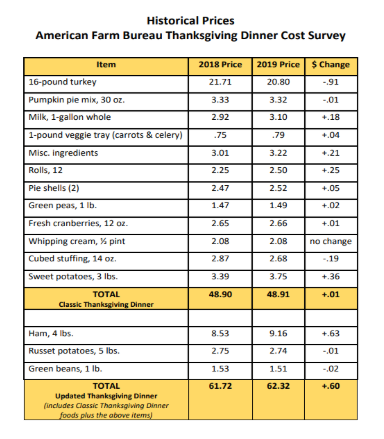Both the historical costs, as well as the history itself, may surprise.
By J. Richard Fredericks, Main Management
For 34 years, the American Farm Bureau has released an annual survey of the total cost of the items that make up a classic Thanksgiving Dinner for 10 people. This year the full meal tally came in at $48.91, which is essentially unchanged at only one penny higher than last year’s result of $48.90, and after three years of price declines since 2015. The cost of a Thanksgiving dinner remains less than $5 per person and lower than it was back in 2012.
To determine the price of the dinner, the Farm Bureau uses 250 volunteer shoppers who have checked prices in 38 states to look for the best possible prices without taking advantage of any special promotions.
The shopping list for the Farm Bureau’s survey includes the turkey in addition to stuffing, sweet potatoes, rolls with butter, peas, cranberries, a veggie tray, pumpkin pie with whipped cream, and coffee and milk in quantities to serve 10 people with plenty of leftovers.
Some of this year’s survey results indicated that –
- The turkey itself amounts to 42.5% of the cost of the total dinner this year. The turkey (measured as a 16-pound bird) cost $20.80 this year and had one of the most significant declines in price of any of the components for this years’ Thanksgiving meal. The cost of the bird is $0.91, or 4.2% lower than the previous year and equates to roughly $1.30 per pound. The table below shows the cost of the turkey for each year and how consistent the price has been over the years and current consumers are enjoying the lowest absolute prices and price per pound over the time frame that is shown.
- The aggregate of the other ingredients is higher this year ($28.11 vs. $27.19, or up 3.4%) as 7 out of the 11 non-turkey items registered an increase, while two items decreased as can be seen in the table below.
- The cost of the Thanksgiving in inflation adjusted, real terms is $19.13 this year, down 1.2% from a year ago continuing a decline since at least 2013. The cost of a Thanksgiving dinner in 1986 would have been $66.89 (in 2019 dollars), which translates into a Thanksgiving meal that is 27% cheaper than it was 34 years ago!
- Even more impressive is how much less time it takes the average worker to afford their Thanksgiving feast. The average US production worker earns $23.70 per hour according to the Bureau of Labor Statistics. That hourly wage would suggest that it would take 2.06 hours of work to afford a classic Thanksgiving Dinner for 10 people ($48.91/$23.51 = 2.06 hours). That result is 3.7% lower in terms of hours worked versus last year when it would have taken 2.14 hours. Just since 2014, to afford the classic Thanksgiving dinner, the average worker needs to work 13.4% less which equates to more than one half of an hour less.
- Looking back even further in time, the cost of a Thanksgiving Dinner took 3.21 hours of work in 1986. Thus, today’s family can afford the same classic Thanksgiving Dinner experience while working 2.06 hours, or 36% less than what it cost the 1986. Clearly the American worker has benefitted from productivity in food production.
Other Interesting Thanksgiving Facts
- In the United States, football is a major part of the Thanksgiving celebration. Dating back to the first college football game between Rutgers and Princeton that was held on Thanksgiving Day in 1869, football games have since become synonymous with Thanksgiving ever since. Many have grown up watching professional games on Thanksgiving. The Detroit Lions started the tradition in 1934 and are slated to play their 75th Thanksgiving game this year.
- The Turkey Trot, a ballroom dance in the 1900s, was named for the short, jerky steps of the turkey. It became popular mainly because the Vatican denounced it as “suggestive”.
- Another tradition of Thanksgiving is the Macy’s Day Parade. Most don’t realize, however, that the tradition actually started in 1920 when the Gimbels department store in Philadelphia held a parade of about 50 people. The first “Macy’s” Thanksgiving Day parade took place in 1924 was launched in 1924 by Louis Bamberger in Newark, New Jersey, at the Bamberger’s store, but was moved to New York City by Macy’s to showcase the opening of the “World’s Largest Store” in New York City. That parade featured 400 employees who were mainly first-generation immigrants who wanted to celebrate with the types of festivals that were celebrated in Europe. While the parade didn’t have the huge balloon floats that we see today, it originally featured live animals from the Central Park Zoo. The inaugural 1924 pageant was originally slated to be a Christmas parade, but was renamed the Thanksgiving Day Parade three years later. The only years the parade didn’t take place was during World War II in 1942, 1943, and 1944.
- A Thanksgiving mix-up inspired the first TV dinners. In 1953, someone at Swanson ordered far too many turkeys in preparation for Thanksgiving (260 tons too much!). After the holiday came and went, the company had more frozen turkeys than they knew what to do with. As a solution, an employee decided to package cooked turkey, side dishes, and froze them together as a meal. They were originally sold for $0.98 and over 10 million were sold because of a mistake. This was the birth of the TV dinner.
Happy Thanksgiving to everyone from all of us at Main Management!
A pioneer in managing all-ETF portfolios, Main Management LLC is committed to delivering liquid, transparent and cost-effective investment solutions. By combining asset allocation insights with smart implementation vehicles, Main Management offers a unique approach that translates into distinct advantages for our clients, including diversification, cost efficiency, tax awareness and transparency. http://www.mainmgt.com





